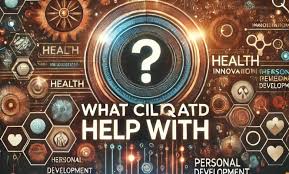What CILFQTACMITD Help With: A Comprehensive Guide 2025

In the ever-evolving landscape of technology and innovation, new tools and methodologies are constantly emerging to address complex challenges across various industries. One such intriguing concept is CILFQTACMITD, a term that has recently gained attention for its potential to revolutionize problem-solving and decision-making processes.
While the acronym itself may seem cryptic, its applications are vast and impactful. In this article, we will delve into what CILFQTACMITD is, how it works, and the myriad ways it can be utilized to enhance efficiency, productivity, and innovation.
What is CILFQTACMITD?
CILFQTACMITD stands for Comprehensive Integrated Learning Framework for Qualitative and Quantitative Task Analysis, Collaborative Management, and Iterative Decision-making.
At its core, it is a multidisciplinary framework designed to streamline complex processes by integrating qualitative and quantitative data analysis, fostering collaboration, and enabling iterative decision-making.
This approach is particularly useful in environments where data-driven insights and human expertise must work in tandem to achieve optimal outcomes.
The framework is built on several key pillars:
- Comprehensive Data Integration: Combining qualitative (e.g., expert opinions, customer feedback) and quantitative (e.g., metrics, analytics) data to provide a holistic view of a problem or scenario.
- Task Analysis: Breaking down complex tasks into manageable components to identify inefficiencies and opportunities for improvement.
- Collaborative Management: Encouraging teamwork and cross-functional collaboration to leverage diverse perspectives and expertise.
- Iterative Decision-making: Implementing a cyclical process of testing, learning, and refining decisions to adapt to changing conditions.
Key Applications of CILFQTACMITD
CILFQTACMITD is a versatile framework that can be applied across various domains. Below are some of the most notable applications:
1. Business Strategy and Management
In the corporate world, CILFQTACMITD can be used to enhance strategic planning and operational efficiency. By integrating qualitative insights from employees and stakeholders with quantitative data from market research and financial reports, organizations can make more informed decisions.
For example, a company launching a new product can use the framework to analyze customer feedback, sales forecasts, and production costs to refine its strategy iteratively.
2. Healthcare and Medical Research
The healthcare industry can benefit significantly from CILFQTACMITD’s ability to combine patient data, clinical trials, and expert opinions. For instance, in drug development, researchers can use the framework to analyze trial results, incorporate feedback from medical professionals, and adjust their approach to improve efficacy and safety.
Evolution of CILFQTACMITD in Healthcare
The development of CILFQTACMITD in healthcare has seen significant milestones over the years:
- 2000: Initial concepts for international medical team management were introduced, focusing on improving coordination and efficiency in global healthcare settings.
- 2010: Digital monitoring for credential tracking was introduced, enabling healthcare organizations to manage and verify staff qualifications more effectively.
- 2020: The COVID-19 pandemic accelerated the widespread adoption of CILFQTACMITD, as the need for efficient healthcare deployment and resource management became critical.
3. Education and Training
Educational institutions and training programs can leverage CILFQTACMITD to design more effective curricula and learning experiences. By analyzing student performance data (quantitative) and gathering feedback from educators and learners (qualitative), the framework can help identify gaps in knowledge delivery and create iterative improvements.
4. Technology and Software Development
In the tech industry, CILFQTACMITD can streamline software development processes. By integrating user feedback (qualitative) with performance metrics (quantitative), development teams can prioritize features, fix bugs, and enhance user experience through iterative updates.
5. Environmental and Urban Planning
Urban planners and environmental scientists can use CILFQTACMITD to address complex challenges such as climate change and sustainable development. The framework enables the integration of data from environmental sensors, community feedback, and economic models to create adaptive and resilient solutions.
Benefits of Using CILFQTACMITD
The adoption of CILFQTACMITD offers numerous advantages, including:
- Holistic Problem-Solving: By combining qualitative and quantitative data, the framework provides a more comprehensive understanding of issues, leading to better solutions.
- Enhanced Collaboration: The emphasis on collaborative management fosters teamwork and ensures that diverse perspectives are considered.
- Adaptability: The iterative nature of the framework allows for continuous improvement and adaptation to new information or changing circumstances.
- Efficiency: Breaking down tasks and analyzing them systematically helps identify inefficiencies and optimize processes.
- Innovation: The integration of diverse data sources and collaborative approaches often leads to creative and innovative solutions.
Tiered Pricing and Benefits
CILFQTACMITD is available in different tiers to cater to the varying needs of organizations:
| Tier | Cost | Benefits |
|---|---|---|
| Basic | $5,000/year | Streamlines staff deployment and basic tracking. |
| Pro | $10,000/year | Adds predictive analytics and reporting capabilities. |
| Enterprise | $20,000/year | Offers full integration with existing systems and advanced risk mitigation. |
Challenges and Considerations
While CILFQTACMITD offers significant benefits, it is not without challenges. Implementing the framework requires:
- Resource Allocation: Gathering and analyzing both qualitative and quantitative data can be resource-intensive.
- Expertise: Teams must possess the skills to interpret data and apply insights effectively.
- Cultural Shift: Organizations may need to adopt a more collaborative and iterative mindset, which can require cultural change.
Conclusion
CILFQTACMITD represents a powerful approach to tackling complex problems in a structured and adaptive manner.
By integrating qualitative and quantitative data, fostering collaboration, and embracing iterative decision-making, this framework has the potential to drive innovation and efficiency across various industries.
As organizations continue to navigate an increasingly complex world, tools like CILFQTACMITD will play a crucial role in shaping the future of problem-solving and decision-making.
Whether you’re a business leader, researcher, educator, or technologist, understanding and leveraging CILFQTACMITD could be the key to unlocking new levels of success and impact in your field.
With its tiered pricing options, organizations of all sizes can access the benefits of this transformative framework, making it a versatile solution for a wide range of challenges.







One thought on “What CILFQTACMITD Help With: A Comprehensive Guide 2025”